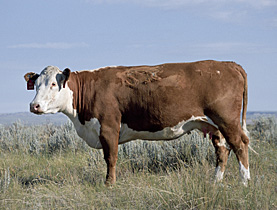Scientists crack the cow code

Researchers have created the first genetic blueprint of domestic cattle, a map they say may lead to tastier beef, better milk and perhaps new insights into human health.
The Hereford cow’s gene map is the first livestock sequence, and the scientists think it will help explain how cattle evolved, why they ended up with a four-chambered stomach, and why they almost never get cancer.
“This genome opens the door for new studies,” said Evgeny Zdobnov of Geneva University, one of 300 scientists from 25 countries who worked on the project. “It’s a kind of bible for researchers.”
The sequencing itself was carried out in Texas, while other researchers drew up the map.
The scientists discovered the cattle genome contains at least 22,000 genes, more than three quarters of which are shared with humans, who have more or less the same number of genes.
And the team found that cattle have far more in common genetically with humans than mice or rats, and might make better subjects for studying human health.
Humans share a more recent common ancestor with rodents than cows, but our genome is still closer to that of cattle. This is probably because mice and rats evolve more quickly than other species thanks to rapid reproduction, according to the researchers.
“Mice have for example developed more genes for the sense of smell,” Zdobnov told swissinfo. “Humans on the other hand have lost some of those abilities.”
For the Geneva-based scientist, future discoveries based on the cow genome might be transferable to humans. “It could be very useful for human medical genetics,” he added.
Differences
But a major finding for the scientists involved in the six-year effort – including researchers from Lausanne University and the Swiss Institute of Bioinformatics– was how different species are.
“The most exciting result that we have is the discovery of the really species-specific genome features,” said Harris Lewin of the University of Illinois, who worked on the research published this week in two reports in the journal Science.
“Those features of the genome that tell us more of what makes a cow a cow, a horse a horse, a sheep a sheep and what makes a human a human.”
The map shows for example that cattle have more than a 1,000 specific genes, which might help explain why they have four stomachs, a different immune system to other species or how they transform grass into highly nutritious milk.
Part of the research also involved looking at the evolution of cattle DNA and the animals’ origins. Present cattle apparently came from a diverse ancestral population from Africa, Asia and Europe that has undergone a recent rapid decrease in population size, most likely because of domestication.
The researchers hope to use this map of genetic diversity to find traits for better meat and milk production. But they aren’t the only ones.
Better cows?
The United States Department of Agriculture also said the discoveries were extremely important for the $49 billion (SFr56 billion) cattle industry, which financed part of the research.
“Understanding the cattle genome and having the sequence will allow researchers to understand the genetic basis for disease in domestic cattle and could result in healthier production of meat and milk while reducing producers’ dependence on antibiotics,” added Agriculture Secretary Tom Vilsack in a statement.
“Knowing the genome can be very useful for breeding purposes,” said Zdobnov. “Selection is haphazard since it is difficult to know what traits are being passed on from one generation to the next.”
“It would reduce the likelihood of complications and make breeding much more efficient.”
Genetic testing would also be more cost-effective and would offer better success rates than traditional breeding methods, which require artificially inseminating at least 100 cows and seeing what happens. This technique can cost anything up to SFr50,000 according to Swiss breeders.
“This will affect how breeders work in the future,” said Zdobnov, who warns though that it could open the door to a loss of biodiversity if they focus too heavily on certain traits.
“Some bloodlines could die out, so we have to ensure that lines are maintained,” he added.
swissinfo, Scott Capper
Every organism, including humans, has a genome containing the biological information needed to build and maintain a living example of that organism.
The biological information contained in a genome is encoded in its deoxyribonucleic acid (DNA) and is divided into discrete units called genes.
A single gene therefore consists of a unique sequence of DNA that provides the complete instructions to make a functional product, called a protein.
Genes instruct each cell type — such as skin, brain, and liver — to make discrete sets of proteins at just the right times, and it is through this specificity that unique organisms arise.

In compliance with the JTI standards
More: SWI swissinfo.ch certified by the Journalism Trust Initiative











You can find an overview of ongoing debates with our journalists here . Please join us!
If you want to start a conversation about a topic raised in this article or want to report factual errors, email us at english@swissinfo.ch.